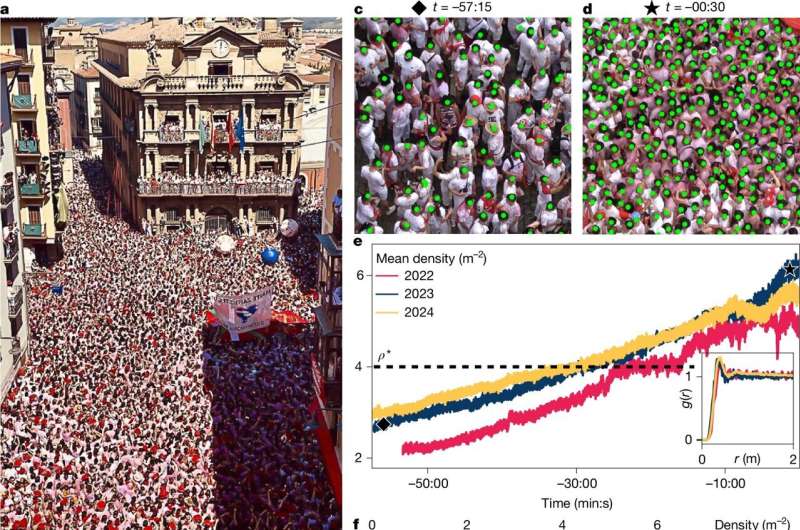The collective motion of large crowds may be predictable past a certain density of people in a given area, according to a study published in Nature. The findings, based on four years of observations at a traditional Spanish festival, offer insights that could help to predict dangerous crowd behavior in confined environments.
Dense crowds, such as those at concerts or festivals, can be a major hazard as hundreds of individuals can move en masse, leading to crushing, potential suffocation and death. Understanding how people in large crowds move in relation to each other can help prevent tragedy, but the dynamics in groups containing thousands of people have been difficult to describe or model especially due to the lack of repeatable and safe experiments at such a scale.
Denis Bartolo and colleagues tracked the crowds of an estimated 5,000 people over four instances of the San Fermín festival in Pamplona, Spain, using cameras placed in two observation spots in the plaza, which is 50 meters long and 20 meters wide. Through their footage and a mathematical model—where people are so packed that crowds can be treated as a continuum, like a fluid—the authors found that the density of the crowds changed from two people per square meter in the hour before the festival began to six people per square meter during the event.
They also found that the crowds could reach a maximum density of 9 people per square meter. When this upper threshold density was met, the authors observed pockets of several hundred people spontaneously behaving like one fluid that oscillated in a predictable time interval of 18 seconds with no external stimuli (such as pushing).
To establish the general nature of their findings, the authors compare footage from the San Fermín festival in Spain to that from the 2010 Duisburg Love Parade in Germany during which several hundred people in a panicked crowd were injured and 21 people died. Bartolo and colleagues found that when the Duisburg crowd reached a density similar to that of the San Fermín festival, the same oscillations were observed.
The authors note that these findings could offer insights into how to anticipate the behavior of large crowds in confined spaces.
More information:
François Gu et al, Emergence of collective oscillations in massive human crowds, Nature (2025). DOI: 10.1038/s41586-024-08514-6
Provided by
Nature Publishing Group
Citation:
Spanish ‘running of the bulls’ festival reveals crowd movements can be predictable, above a certain density (2025, February 5)
retrieved 5 February 2025
from https://phys.org/news/2025-02-spanish-bulls-festival-reveals-crowd.html
This document is subject to copyright. Apart from any fair dealing for the purpose of private study or research, no
part may be reproduced without the written permission. The content is provided for information purposes only.

